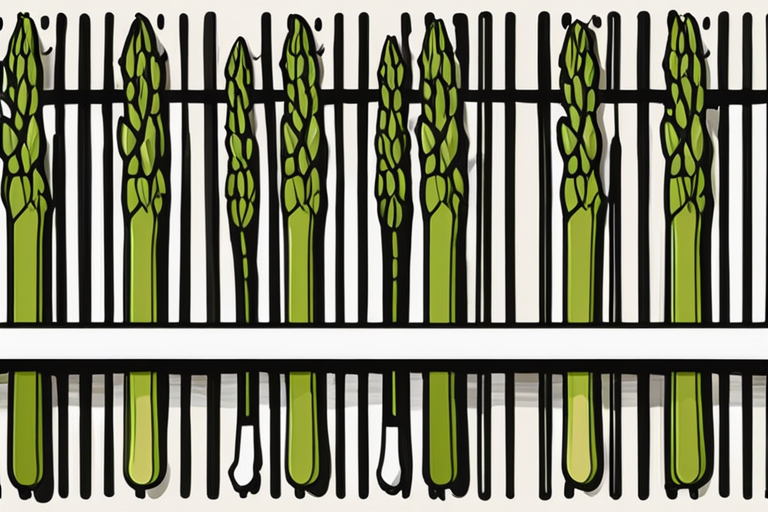
Maximizing Shelf Life: The Best Way to Store Asparagus
Get Your Free Food Safety Cheat Sheet
30 most common foods with instant answers. Print it and stick it on your fridge—completely free!
Maximizing Shelf Life: The Best Way to Store Asparagus
Asparagus is a versatile and delicious vegetable that can be enjoyed in a variety of dishes. To ensure that your asparagus stays fresh and flavorful for as long as possible, proper storage is key. In this guide, we will explore the best ways to store asparagus to maximize its shelf life. (Asparagus)
Understanding the Importance of Proper Storage
Proper storage of asparagus is essential to maintain its quality and flavor. When stored correctly, asparagus can stay fresh for up to a week or even longer. By following the right storage methods, you can prevent your asparagus from wilting, becoming mushy, or developing off-flavors.
Factors Affecting Asparagus Shelf Life
Several factors can impact the shelf life of asparagus, including:
- Temperature: Asparagus should be stored at the right temperature to slow down the rate of deterioration.
- Humidity: Maintaining the right level of humidity can prevent asparagus from drying out.
- Air Exposure: Exposure to air can cause asparagus to lose moisture and become limp.
- Light: Excessive light exposure can lead to the degradation of nutrients in asparagus.
Tips for Properly Storing Asparagus
1. Choose Fresh Asparagus:
- Look for firm, bright green stalks with tightly closed tips.
- Avoid purchasing asparagus with wilted or slimy stalks.
2. Trim and Prep Asparagus:
- Trim the woody ends of the asparagus stalks before storing.
- Wash the asparagus under cold water to remove any dirt or debris.
3. Storage Methods:
-
Refrigerator Storage:
- Wrap the trimmed asparagus in a damp paper towel.
- Place the wrapped asparagus in a plastic bag or airtight container.
- Store the asparagus in the vegetable crisper drawer of the refrigerator.
-
Water Storage:
- Stand the asparagus upright in a glass or jar with an inch of water.
- Cover the asparagus loosely with a plastic bag.
- Change the water every 2-3 days.
4. Avoid Freezing Asparagus:
- While asparagus can be frozen for long-term storage, freezing can affect its texture and flavor.
- If you choose to freeze asparagus, blanch it first and store it in airtight containers.
5. Regularly Check and Use Asparagus:
- Check the condition of the asparagus regularly and use it before it starts to wilt or develop a slimy texture.
- Asparagus is best enjoyed when fresh, so try to use it within a few days of purchase.
Safety Tips for Storing Asparagus
When storing asparagus, it's essential to follow proper food safety practices to prevent contamination and ensure the freshness of the vegetable.
- **Keep the asparagus away from raw meat, poultry, or seafood to avoid cross-contamination.
- **Wash your hands before and after handling asparagus to prevent the spread of bacteria.
- **Store asparagus at the right temperature to inhibit the growth of harmful bacteria.
- **Discard any asparagus that shows signs of mold, sliminess, or off-odors.
Conclusion
Proper storage is crucial for maintaining the quality and shelf life of asparagus. By following the tips outlined in this guide, you can ensure that your asparagus stays fresh, crisp, and flavorful for as long as possible. Remember to store your asparagus in the refrigerator, trim and prep it correctly, and use it within a few days for the best results. Enjoy your delicious asparagus in salads, stir-fries, or as a side dish knowing that you have stored it properly to maximize its shelf life. (Asparagus)

Authoritative Food Safety References
These agencies and university labs inform every tip and health precaution we publish.
USDA FoodKeeper – Cold Storage Guidelines
Official refrigerator, freezer, and pantry timelines maintained by the U.S. Department of Agriculture.
Visit USDA FoodKeeperFDA Produce Safety Rule & Grower Guidance
Field-to-fridge handling practices that prevent contamination of fruits, vegetables, and leafy greens.
Visit FDA Produce SafetyCDC Foodborne Illness Prevention Hub
Surveillance-backed guidance on pathogens, symptoms, and steps to reduce foodborne illness risk.
Visit CDC Food SafetyUC Davis Postharvest Technology Center
University research detailing optimal storage atmospheres for produce after harvest.
Visit UC Davis PostharvestPenn State Extension – Home Food Preservation & Safety
Peer-reviewed extension bulletins on safe canning, chilling, and reheating practices.
Visit Penn State ExtensionCan I freeze asparagus to extend its shelf life?
How long can I keep asparagus in the refrigerator before it goes bad?
Can I store asparagus at room temperature?
How can I tell if asparagus has gone bad?
Get Your Free Food Safety Cheat Sheet
30 most common foods with instant answers. Print it and stick it on your fridge—completely free! Want more? Upgrade to the complete guide with 70+ foods.
Scan your food directly and get instant safety info using our AI-powered camera feature.